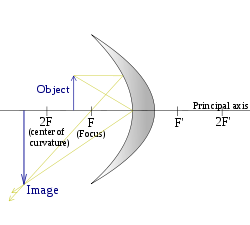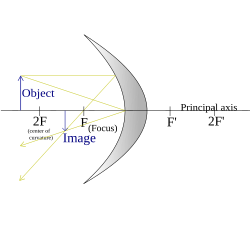What is the nature of image formed by convex and concave lens and mirrors and how to show the light reflected by them?
Hi Vineet!
The summary of image formed by concave and convex lenses is given below:
Convex lens:

Concave lens:

The summary of image formed by concave and convex mirrors is given below:
Concave mirror:

ntroduction to image formation by lenses: While attempting to draw the image formation by both convex and concave lenses, we need to know a few rules: Let us first see the image formation by a convex lens: Object –at 2F Object – beyond 2F Object – between O and F Let us now see the image formation by a concave lens: Object – at infinity Object – between infinity and the optic centreImage Formation by Convex Lens
Object – at infinity
Image – at F
Nature of image – real and inverted
Size of Image – point sized
Object – between F and 2F
Image – beyond 2F
Nature of image – real and inverted
Size of Image – enlarged
Image –at 2F
Nature of image – real and inverted
Size of Image – same size as that of object
Image – between F and 2F
Nature of image – real and inverted
Size of Image – diminished
Image – On the same side as that of the object or behind the lens
Nature of image – virtual and erect
Size of Image – enlarged
Object – at F
Image – at infinity
Nature of image – real and inverted
Size of Image – highly enlargedImage Formation by Concave Lens
Image – at F
Nature of image – virtual and erect
Size of Image – point sized
Image – between O and F
Nature of image – virtual and erect
Size of Image – diminished
- 18
A convex mirror, fish eye mirror or diverging mirror, is a curved mirror in which the reflective surface bulges toward the light source. Convex mirrors reflect light outwards, therefore they are not used to focus light. Such mirrors always form a virtual image, since the focus (F) and the centre of curvature (2F) are both imaginary points "inside" the mirror, which cannot be reached. Therefore images formed by these mirrors cannot be taken on screen. (As they are inside the mirror) A collimated (parallel) beam of light diverges (spreads out) after reflection from a convex mirror, since the normal to the surface differs with each spot on the mirror. The passenger-side mirror on a car is typically a convex mirror. In some countries, these are labeled with the safety warning "Objects in mirror are closer than they appear", to warn the driver of the convex mirror's distorting effects on distance perception. Convex mirrors are preferred in vehicles because they give an upright, though diminished, image. Also they provide a wider field of view as they are curved outwards. Convex mirrors are used in some automated teller machines as a simple and handy security feature, allowing the users to see what is happening behind them. Similar devices are sold to be attached to ordinary computer monitors. Some camera phones use convex mirrors to allow the user to correctly aim the camera while taking a self-portrait. The image is always virtual (rays haven't actually passed through the image,their extensions do), diminished (smaller), and upright . These features make convex mirrors very useful: everything appears smaller in the mirror, so they cover a wider field of view than a normal plane mirror does as the image is "compressed". A concave mirror, or converging mirror, has a reflecting surface that bulges inward (away from the incident light). Concave mirrors reflect light inward to one focal point, therefore they are used to focus light. Unlike convex mirrors, concave mirrors show different image types depending on the distance between the object and the mirror. These mirrors are called "converging" because they tend to collect light that falls on them, refocusing parallel incoming rays toward a focus. This is because the light is reflected at different angles, since the normal to the surface differs with each spot on the mirror.[edit]Uses
[edit]Image
Concave mirrors

[edit]Uses
[edit]Image
- 35
Copyright © 2024 Aakash EduTech Pvt. Ltd. All rights reserved.















